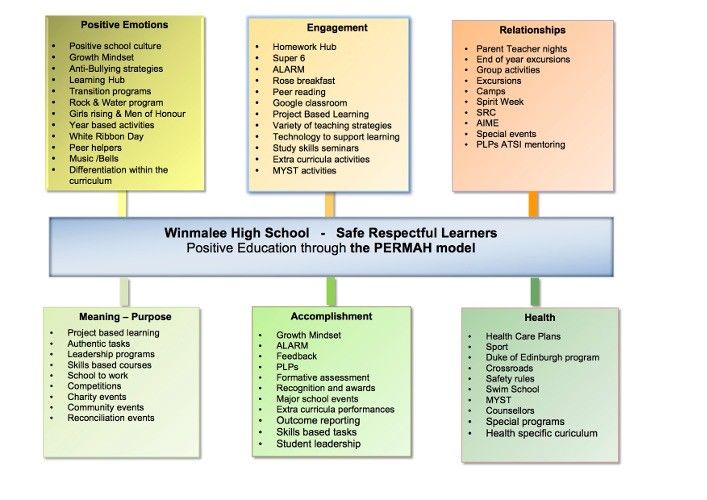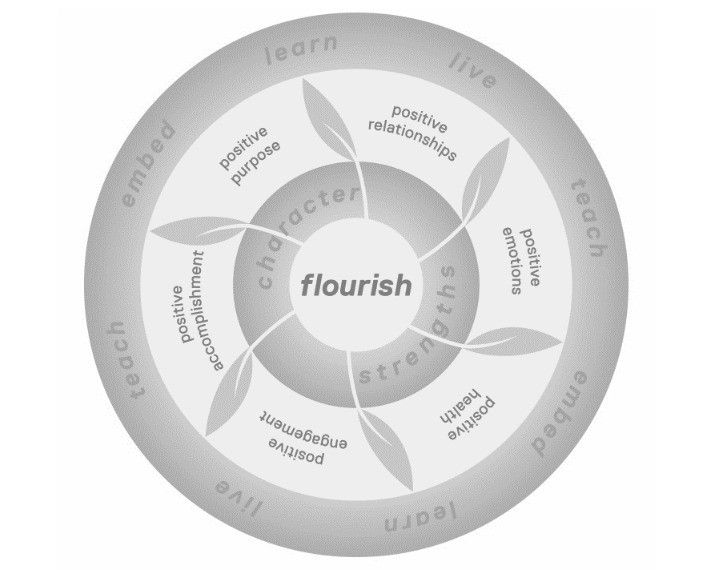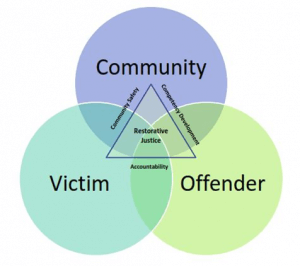

All parents want the best for their children.
They want their children to be happy and to flourish. They want them to live out their dreams and reach their innate potential.
The challenge, however, is finding the right education model. One that doesn’t stifle their potential nor produce cookie-cutter pupils.
An excellent option to consider is positive education, which combines traditional education principles with research-backed ways of increasing happiness and wellbeing.
The fundamental goal of positive education is to promote flourishing or positive mental health within the school community.
Norrish, Williams, O’Connor, & Robinson, 2013
Continue exploring this article to learn more about the emerging field of positive education and how it is transforming lives around the world.
Before you continue, we thought you might like to download our three Positive Education Exercises for free. These ready-made tools are perfect for enhancing your teaching approach, making it easier to engage students in meaningful, student-centered learning.
Positive education is the combination of traditional education principles with the study of happiness and wellbeing, using Martin Seligman’s PERMA model and the Values in Action (VIA) classification.
Seligman, one of the founders of positive psychology, has incorporated positive psychology into education models as a way to decrease depression in younger people and enhance their wellbeing and happiness. By using his PERMA model (or its extension, the PERMAH framework) in schools, educators and practitioners aim to promote positive mental health among students and teachers.
PERMA encompasses five main elements that Seligman premised as critical for long-term wellbeing:
The PERMAH framework adds Health onto this, covering aspects such as sleep, exercise, and diet as part of a robust positive education program (Norrish & Seligman, 2015).
The figure below is provided by Winmalee High School (2020) in New South Wales, and it shows how the PERMAH framework has been applied in practice through elements such as project-based learning, anti-bullying strategies, and more.

Source: Winmalee High School, 2020
Below, you’ll find another example from Geelong Grammar School, one of the earliest models in the field (Norrish et al., 2013).

Source: Norrish et al., 2013, in Hoare, Bott, & Robinson, 2017, p. 59
Education has long focused on academics and fostering positive character strength development. However, before the publication of Character Strengths and Virtues: A Handbook and Classification by Peterson and Seligman (2004), any efforts to endorse character strengths were derived from religious, cultural, or political bias (Linkins, Niemiec, Gillham, & Mayerson, 2015).
The VIA classification, however, provides a cross-culturally relevant framework for ‘educating the heart’ (Linkins et al., 2015, p. 65).
Positive education programs usually define positive character using the core character strengths that are represented in the VIA’s six virtues:
These positive characters aren’t innate; they’re external constructs that need to be nurtured. The goal of positive education is to reveal children’s combination of character strengths and to develop their ability to effectively engage those strengths (Linkins et al., 2015).
In practice, integrating character strengths into curricula can involve collecting information on students’ VIA strengths, talents, and interests when they enroll.
Revisiting these and communicating them to students throughout their academic journey can also be excellent ways to validate and nurture strengths (Robinson, 2019).
Self-report measures such as the Values in Action Inventory of Strengths for Youth may be useful (Park & Peterson, 2006).
Strengths-based interventions in educational systems are powerful tools that are often surprisingly simple to introduce.
“A school curriculum that incorporates wellbeing will ideally prevent depression, increase life satisfaction, encourage social responsibility, promote creativity, foster learning, and even enhance academic achievement”
The Geelong Grammar School (GGS) in Australia has often been cited as a model for positive education, since it was one of the first schools to apply positive psychology approaches school wide (Norrish & Seligman, 2015).
At GGS, all teachers and support staff participate in training programs to learn about positive education and how to apply its teachings in both their work and personal lives (Norrish & Seligman, 2015).
For students at the school, positive education is incorporated into every course. For example, in an art class, students might explore the concept of flourishing by creating a visual representation of the concept. The students also have regular lessons on positive psychology, just like they would with subjects like mathematics and geography (Norrish & Seligman, 2015).
These strengths-based interventions also focus on the relationship between teachers and students. When a teacher gives feedback, they are instructed to be specific about the strength the student demonstrated rather than giving vague feedback like “Good job!”
Changes to these small interactions are significant, and paying attention to the wording of positive reinforcement can make a difference. A study of praise conducted by Elizabeth Hurlock (1925) found it a more effective classroom motivator than punishment regardless of age, gender, or ability.
The following video summarizes the innovative ways schools are incorporating positive education into their curriculum.
In Australia, one school focuses on wellbeing, under the belief that humans learn best when they are happy. The video above explains the application of positive psychology into the school system at GGS.

The tenets of positive psychology have been used to create several teaching techniques proven to be effective in several ways.
Here are just a sample of some ways to incorporate this model into any classroom or school system.
The jigsaw classroom is a technique in which students are split into groups based on shared skills and competencies. Each student is assigned a different topic and told to find students from other groups who were given the same topic. The result is that each group has a set of students with different strengths, collaborating to research the same topic.
The influence of positive psychology has even extended to classroom dynamics. In positive psychology-influenced curricula, more power is given to the students in choosing their curriculum, and students are given responsibility from a much younger age. In these types of classroom settings, students are treated differently when it comes to praise and discipline.
In Paul Tough’s (2013) book How Children Succeed, he argues that possessing inborn intelligence and academic competency is not enough for students to succeed in school. Instead, he argues that grit, resilience, and other character traits should receive a greater emphasis in schools. Doing so leads to better near-term academic performance in students.
The acclaimed charter school network KIPP took many of these ideas and made them an official part of school protocol. Students at KIPP schools receive a Character Growth Card, which evaluates students’ performance not just for academic subjects like math and history, but also regarding a series of seven character traits. These traits are culled from positive psychology research by Seligman and psychologist Chris Peterson.
KIPP’s system enables the formal assessment of traits that fall outside the metrics used to assess students at most schools, and it teaches the importance of these character traits in a few ways. Teachers model positive behavior, call out positive examples of the character traits in action, and discuss the traits openly and explicitly.
There are no formal lessons teaching character traits like zest or gratitude. Still, KIPP faculty believe that highlighting examples of these traits when they naturally occur is an effective way to encourage their development.
Not everyone seems to believe that KIPP’s method is effective. In an article in The New Republic, education professor Jeffrey Snyder (2014) argues that we don’t actually know how to teach character strengths, so numerically measuring them can do more harm than good.
Even critics of KIPP agree that calling attention to character and positive psychology in schools is a step in the right direction.
Researchers Toni Noble and Helen McGrath (2008) devised a practical, cost-effective, and efficient classroom resiliency program called Bounce Back, the first positive education program in the world.
Noble and McGrath (2008) argue that teaching resilience to young children is most useful for lasting change, but that the most pressing need for increased resilience is during students’ transition into secondary school.
The Bounce Back program is targeted to upper primary and lower secondary students, as adolescence is a critical period of change and stress for students. This concept is summarized by their video below:
Bounce Back addresses two key areas: the environmental factors that build up psychological capital and the personal coping skills that students can learn, the importance of which has been highlighted by many researchers such as Reivich and Shatté (2002), and Barbara Fredrickson (2001).
Noble and McGrath (2008) provided a series of practical, day-to-day school activities that helped students feel connected to their peers, school, and the community. Their research showed how schools could create a more supportive environment, both within the school and in students’ families and communities.
To help students develop coping skills, the Bounce Back curriculum provides resources and suggestions for teachers and exercises for pupils. The exercises are designed to encourage pupils to develop optimism in the classroom and grow an accepting and light-hearted attitude.
Bounce Back provides practical tools such as a responsibility pie chart, which guides children to realize that all negative situations are a combination of three factors: their own behavior, the behavior of others, and random events.
Using the responsibility pie chart to understand a specific negative event helps pupils learn what they can change and what they can’t, developing their senses of initiative and responsibility.
These principles have proven useful for other positive psychology client groups. Participants in Possibility Place, a program for boosting resilience and confidence in the long-term unemployed, found the responsibility pie chart very useful in preventing people from berating themselves for things that were not their fault and learning to understand what they could do to resolve the situation.
Bounce Back is a wonderful example of how positive psychology research can be transmuted into tools to help people flourish.
As positive education grows in popularity across the world, there are increasingly more global cases of its implementation at the system level. Some great examples include the following (Seligman & Adler, 2018).
Israel’s Maytiv Positive Education Program starts in pre-school and stretches up to the high school level. While positive psychologists still call for cautious interpretation of extant data, the Maytiv Program has shown some promising results such as enhanced student self-efficacy, positive emotions, a feeling of school belongingness, and improvements in the quantity and quality of social peer ties (Shoshani & Steinmetz, 2014; Shoshani, Steinmetz, & Kanat-Maymon, 2016; Shoshani & Slone, 2017).
Dubai’s Knowledge and Human Development Authority partnered with the South Australian Department of Education to conduct the Dubai Student Wellbeing Census. Following this, some schools in the United Arab Emirates have been established on positive education principles, including rigorous training of all educators and the introduction of dedicated departments such as one school’s “wellbeing department.”
In Mexico, a partnership between the Jalisco Ministry of Education and University of Pennsylvania also resulted in randomized controlled studies at educational institutions, with promising results. Based on these outcomes, a wellbeing curriculum (Currículum de Bienestar) was developed and implemented with beneficial impacts on measures such as academic performance, student connectedness, perseverance, and engagement (Adler, 2016).

Positive education doesn’t just focus on the positive parts of education; it also improves upon how schools administer punishment.
In any given school year, tens of thousands of students are expelled from U.S. public schools. In the 2015–2016 academic year, for example, over 11 million instructional days were lost, according to the ACLU (Washburn, 2018).
Many of these students will be forced to leave their school for an entire academic year, while others will be barred from ever attending a public school in their state.
Considering how many days of school and learning are lost to expulsions and suspensions, some school administrators are starting to rethink those methods. Expulsions and suspensions can sometimes be necessary if a student’s behavior is compromising the safety or learning environment of their fellow students.
Many educators now think these disciplinary measures are unlikely to help children learn from their mistakes or prevent repeat behavior once the offending students are back in school. Some argue that these punishments further alienate these children physically and emotionally from their peers, only making them more likely to repeat harmful behavior (Noble & McGrath, 2008).

An alternative method, called restorative practice, is championed by some as an improvement upon the expulsion and suspension model (McCluskey et al., 2008). Restorative practice isn’t an entirely new concept; it’s based on the restorative justice model that has been championed by criminal justice reform advocates for years.
In this model, a meeting is held between the person who “offended” someone, the person directly affected by the offender, and the community entangled in this domino effect of actions. The Venn diagram above offers a visual as to how these parties intersect.
If a school disciplines a student, it’s usually because the student’s behavior had a specific effect on their environment. The idea behind restorative practice is to focus on that effect when pursuing disciplinary action.
Let’s take a look at an example.
Let’s say Maria was talking too loudly during class, disrupting her peers’ ability to focus. In a traditional disciplinary setting, the teacher might ask Maria to stop talking or give her a time-out.
In restorative practice, the teacher would ask Maria why she was speaking out of turn, what effect she’s having on the students around her, and whether she thinks it’s fair for the other students to be on the receiving end of that behavior.
In a more extreme case, like a student provoking and participating in a fight, the restorative practice would be more formal. The child would participate in a meeting with other students and adult leaders in the school. Together, they would discuss what spurred the student to start the fight, how it affected the others involved, and what the student might do instead if they were in a similar situation in the future (Hendry, 2010).
The student might also be assigned activities or programs that would help prevent further fights. As discussed in an article on restorative practice in EducationWeek, a California middle-schooler named Danny went through a similar process. In Danny’s case, his disciplinary requirements included “writing letters of apology, undergoing tutoring, and joining a school sports team.”
While precise recidivism rates vary based on location, the data on restorative practices shows promising results.

These detailed, science-based exercises will equip educators with tools to foster student well-being and boost academic performance.
Download PDF
By filling out your name and email address below.
“A central question of youth development is how to get adolescents’ fires lit, how to have them develop the complex of dispositions and skills needed to take charge of their lives”
Lots of studies have been done on positive education and its potential impacts. Here are some summaries of research findings on the benefits of positive education.
Clonan, Chafouleas, McDougal, and Riley-Tillman (2004) found that the incorporation of positive psychology in learning environments helped foster individual strengths. It encouraged the development of positive institutions and made students more successful.
Still more research confirms these results, including studies establishing that positive education interventions had a more lasting impact on changing student behavior than other methods (Adler, 2016).
In another study, researchers examined the effects of life coaching on high school students (Green, Grant, & Rynsaardt, 2007).
The results showed that following their life coaching sessions, students showed significant decreases in depression and increases in cognitive hardiness and hope (Green et al., 2007). Students are better equipped to improve their subjective wellbeing in the longer term through greater control over their positive emotional experiences (Fredrickson, 2001; 2011).
Positive psychology interventions that are used in positive education include identifying and developing strengths, cultivating gratitude, and visualizing best possible selves (Seligman, Steen, Park, & Peterson, 2005; Sheldon & Lyubomirsky, 2006; Liau, Neihart, Teo, & Lo, 2016).
A meta-analysis conducted by Sin and Lyubomirsky (2009) with 4,266 participants found that positive psychology interventions do significantly increase happiness and decrease depressive symptoms. Further evidence from randomized clinical trials indicates a similar impact from positive psychology interventions in children (Kwok, Gu, & Kit, 2016).
Among some of the great examples of positive education’s impact on academic performance, we recommend Angela Duckworth’s work on grit, and Shankland and Rosset’s (2017) study on the positive relationship between learner wellbeing and academic performance (Duckworth, Peterson, Matthews, & Kelly, 2007; Villavicencio & Bernardo, 2016; Akos & Kretchmar, 2017; Mason, 2018).
Positive education benefits teachers, too. It creates a school culture that is caring and trusting and prevents problem behavior. Recent research suggests that better teacher–student relationships may benefit student academic performance as well (Košir & Tement, 2014).
Positive education also offers a fresh model of pedagogy that emphasizes personalized motivation in education to promote learning (Seligman, Ernst, Gillham, Reivich, & Linkins, 2009).
Research has shown that goals associated positively with optimism resulted in highly motivated students (Fadlelmula, 2010). This study showed that motivation may be consistent and long term if it is always paired with positive psychology interventions.
Researchers at the University of Pennsylvania developed the Penn Resiliency Program. Results from 19 controlled studies of the Penn Resiliency Program found that students in the program were more optimistic, resilient, and hopeful. Their scores on standardized tests increased by 11%, and they had less anxiety approaching exams (Brunwasser, Gillham, & Kim, 2009).

Since this article was initially published, we’ve seen more and more impressive publications on positive education.
Where many earlier studies on positive psychology focused primarily on adults such as college students, we’re now welcoming research on students as young as pre-schoolers.
There will always be calls for more research, so what’s next, specifically?
Seligman and Adler (2018) suggest the following in a publication on positive education:
Overall, research findings on positive education have been promising so far, and time will tell what the future holds for positive education. Interest in applying positive psychology interventions in schools is certainly growing rapidly.

The Positive Psychology Toolkit© is a groundbreaking practitioner resource containing over 500 science-based exercises, activities, interventions, questionnaires, and assessments created by experts using the latest positive psychology research.
Updated monthly. 100% Science-based.
“The best positive psychology resource out there!”
— Emiliya Zhivotovskaya, Flourishing Center CEO
In the time since Seligman established the basic tenets of positive psychology, it has been implemented worldwide in many ways. While the objective of giving students the tools to build meaningful relationships, feel good, become well rounded, and bring positivity to everything that they do is common among all positive education institutions, each has its own approach.
For example, Perth College trains its staff in positive psychology and coaching and has full lesson units on ethical issues and social justice.
Other schools utilize the Montessori method, which emphasizes student-led, project-based curricula to enhance creativity and hands-on learning.
With the success of many of these approaches and no single dominant method, many organizations are starting to grow in an attempt to consolidate and organize the efforts among different schools.
The International Positive Education Network is one of several institutions attempting to figure out what is working and spread it through means such as conferences and even policy reform.
Recent research has suggested that these sorts of initiatives lead to students growing up with higher levels of creativity, leadership skills, and emotional intelligence (Leventhal et al., 2015). Furthermore, they even lead to improved academic performance and significantly better mental health (Adler, 2016).
With high levels of anxiety and depression in the world today, proactively raising children to handle these problems effectively may be the best antidote we can provide.
Are you interested in reading about how other institutions have embraced positive education or discovering some tactical approaches for teaching strengths? Here is a list of recommended books on topics in positive education.
If you want to learn more about positive education, try watching these videos on the subject. We would also love to hear any additional ideas in our comments section.
This video gives a very brief introduction to positive education and the role it can have on a student’s wellbeing. It also delves into the specific positive psychology techniques used in positive education.
How do positive education instructors teach and observe students differently from traditional teachers?
The video shows teachers reflecting on the program, discussing the benefits of “talking back,” focusing on what’s right with children and teenagers, and rebuilding a school’s culture.
Geelong Grammar School, as described above, is taking an innovative approach in their students’ wellbeing.
This video explains how the school helps students cope with the stressors of life and gives a glimpse of what goes on in a positive education classroom. What makes this video remarkable is it shows how self-aware the students are.
At Perth College, skills of wellbeing are taught to girls as a core part of their educational program. “It’s important to start at a really young age,” the school director explains.
This video focuses on a school that has wholly implemented positive education into their school program. It outlines how educators incorporate positive education for every age group, how they help their students flourish, and the results it has had on the staff, too.
If you’re interested in learning more about positive education, be sure to check out the following sources.
As described above, the faculty at Geelong Grammar School believes that wellbeing should be at the heart of education. The school is known for pioneering a whole-school approach to positive education.
Here, you’ll find a positive education podcast, a curriculum to browse, and classroom materials such as the Mindful Moments and Brain Breaks.
IPEN is a network that aims to bring individuals and institutions together to promote positive education.
On the IPEN website, educators can access learning materials such as meditations, vocabulary, video introductions to concepts, and inspiration for lesson plans. IPEN also has an active community of positive educators so users can connect and collaborate.
PESA is a school association working to embed positive psychology into school programs and aiming to improve student wellbeing and academic performance. This association helps schools and teachers gain access to resources and the latest research.
The association’s vision is for an education system that integrates wellbeing science and positive psychology. To this end, PESA facilitates collaboration between positive educators, provides resources, and hosts events.
The Positive Schools Initiative website links to Australian and Asian conferences for educators, as well as the free digital Positive Times magazine. Here, parents and teachers can find news articles and opinion pieces on topics such as creativity, intrinsic motivation, engagement, goals, and other key positive education themes.
The Initiative is based on the contextual wellbeing model, which aims to create positive schools by supporting four interlinked domains: people, social norms, policy and practice, and physical space.

Some useful worksheets can make a great starting point if you’re looking to integrate positive education concepts into your classroom.
Use this worksheet to help students identify positive qualities in their favorite animals, and acknowledge how those strengths can be seen in themselves as well.
Students are invited to reflect on qualities in their favorite animal that represents how they want others to see them. For example, flamingo – elegant, graceful, etc. Next, they select another animal, and list how others may see them. For example, an owl – quiet, shy etc. Lastly, they select yet another animal and identify who they truly are. For example, a monkey – funny, friendly, etc.
Here is the My Favorite Animals worksheet.
The Daily Mood Tracker enables students to keep a record of their emotional state throughout the day. It’s simple to use and facilitates a better understanding of their moods while promoting emotional awareness through self-reflection.
This fun exercise can be used to motivate students to take a more active approach in dealing with challenging events. By understanding their own gifts – traits and talents – they build their self-esteem, vital to being resilient. For example, dealing with peer problems, a student can find the strength to cope by living in line with their strengths, such as being kind or inventive.
The My Gifts – Traits and Talents activity involves four steps, and is a great tool to remind students of their great qualities.

Use these 17 Positive Education Exercises [PDF] to enhance student engagement, resilience, and wellbeing while also equipping students with valuable life skills.
Created by Experts. 100% Science-based.
To encourage positive education in more schools, researchers argue that more practitioners should share their knowledge and experiences. Can you recommend any books, strategies, institutions, or resources to your fellow educators? Do you have a case study from your personal experience?
Or perhaps you’re a researcher who is studying the field – in that case, what’s brand new? What would you like to see more of in positive education curricula?
Let us know; we’d like to hear from you. Share your insights below in our comments section.
We hope you enjoyed reading this article. Don’t forget to download our three Positive Education Exercises for free.
References